The Best Wall Finishes For A Medical Facility!
Unfortunately, walls can be boring, uninspiring, and an unhygienic part of your medical facility.
Fortunately, they don’t have to be! There are so many options when it comes to choosing wall finishes. If the right ones are chosen and applied in the optimal locations, you can transform your practice.
By reading this post, you will discover the best wall finish for the different areas within your facility, and ensure that these spaces are not only stunning, but durable and hygienic.
Paint

There’s nothing like a fresh coat of paint to re-energise your staff and patients! Paint is one of our top choices because it ticks almost all of the boxes at a relatively low cost.
Q) OK, so how do I know what paint to choose?
Everyone facility has different needs when it comes to wall finishes. The two most important aspects of paint, in our opinion, are the colour and the sheen.
Colour:
Light spaces with brighter paint colours open up a medical facility, making it feel bright, clean, and spacious! Carefully consider the colour of your walls to make sure they are light enough to make the space inviting, but not too light to be harsh on the eyes of patients and easily show imperfections.
When it comes to neutral wall colours, some of our favourites are Resene Black White and Resene Sea Fog, as they strike this balance well. Click here to find out more about choosing the perfect white colour for your facility.
Tip: If choosing a white paint, paints with a grey base tend to date less compared to yellow or brown-based paints, keeping your facility looking fresher for longer!
Sheen:
Low-sheen paint is the most common paint sheen that is often used in patient rooms, exam rooms, and hallways. Being only around 10-35% gloss, it is ideal for hiding imperfections on walls and ceilings. It is also easy to touch up, but it isn’t very durable and can be difficult to clean because it isn’t moisture-resistant.
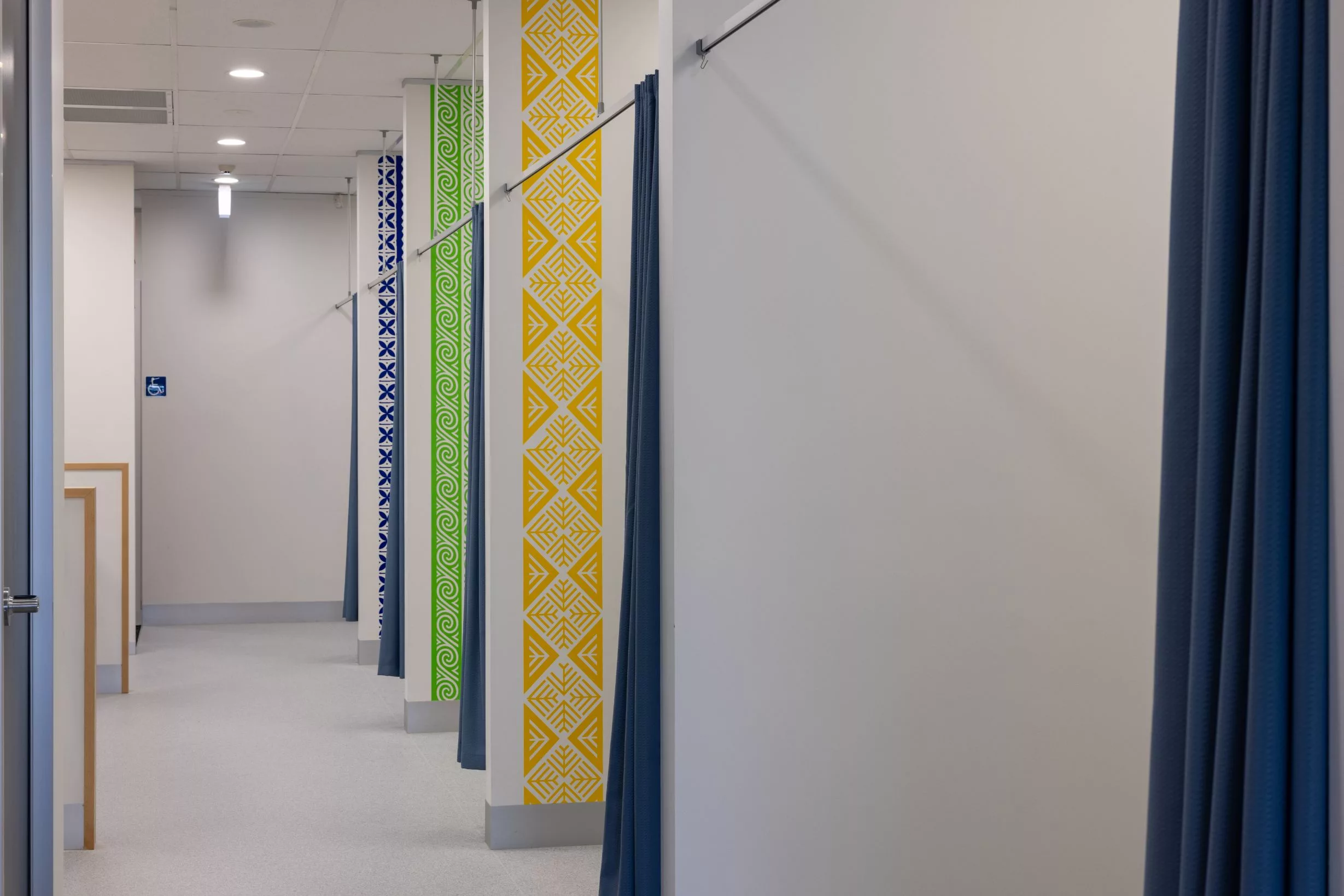 In contrast, Gloss Finish paint has the highest sheen and is very reflective. It is extremely durable and easy to clean, but it is not commonly used in medical facilities as its shiny finish can be distracting for patients. Possessing a harsher clinical feel, it may also make your patients feel uncomfortable. If you do use this paint, we recommend limiting it to areas that are wet and moisture-prone, because of its non-absorbent finish.
In contrast, Gloss Finish paint has the highest sheen and is very reflective. It is extremely durable and easy to clean, but it is not commonly used in medical facilities as its shiny finish can be distracting for patients. Possessing a harsher clinical feel, it may also make your patients feel uncomfortable. If you do use this paint, we recommend limiting it to areas that are wet and moisture-prone, because of its non-absorbent finish.
Between these two extremes, there is a range of options, but our pick is Semi-gloss paint. This is the goldilocks paint for medical facilities—particularly treatment rooms—because its glossy finish makes it very durable and highly resistant to moisture and stains, but it isn’t annoyingly shiny.
In non-surgical areas like consult rooms, a low-sheen paint is completely appropriate, pairing well with the softer feel that carpet tiles exude.
Q) What about low-VOC and anti-microbial paint?
Both options are helpful, but if your surfaces are cleaned well and the air in your facility is well conditioned/filtered, they aren’t a must-have. Flooring is generally more of a concern when it comes to hygiene as it is more dirt and infection-prone than walls.
That being said, both options are effective at making your facility healthier and more hygienic.
Low-VOC and zero-VOC paints are becoming more widely available and are a good choice for medical facilities where air quality and patient health are a priority. These paints are formulated with low levels of solvents and other chemicals that can be harmful, making them a safer option for medical facilities.
Antimicrobial paint is another type of paint that contains additives or agents that are designed to inhibit the growth of pathogens on the painted surface. These paints are therefore commonly used in medical facilities where infection control is critical.
If you can find the right colour and sheen in these paint types, they are a great option! A prime example would be Resene’s ClinicalCote, which is both low VOC and Anti-microbial.
Vinyl Wall Coverings
Vinyl wall coverings are applied to walls similarly to wallpaper. They come in a range of thicknesses, patterns, and textures, allowing your walls to stand out!
In contrast to paint, wall vinyl is thicker and much more durable. It is ideal for anything medical related because it can withstand high traffic and isn’t as susceptible to scuffs or dents, such as from trolleys or wheelchairs. Although it isn’t completely impervious, vinyl is non-absorbent, making it hygienic and suitable for use in bathrooms or areas where contact with water may occur.
Q) What is the best type of vinyl wall covering?
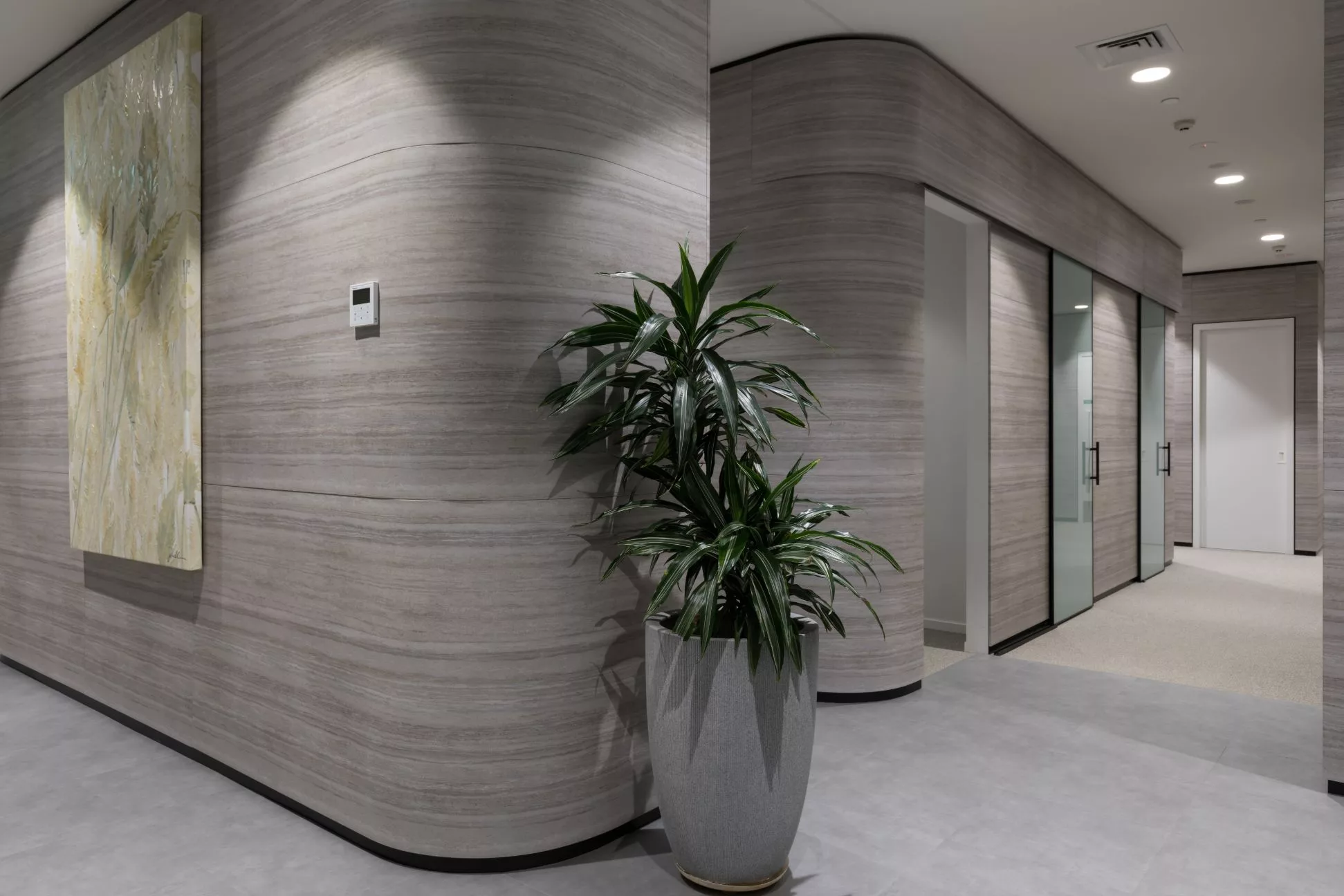
There are many excellent choices for wall vinyl in a Medical Facility.
The main factor to bear in mind is the thickness of the vinyl. Therefore, the optimal vinyl type is either solid sheet vinyl or a fabric-backed vinyl that is either Type 1 or Type 2, meaning it is generally at least 0.5 mms thick and suitable for higher-abrasion areas.
One issue with vinyl wall coverings is their breathability. If a wall vinyl has no breathability and is applied to a wall, it creates a seal where air can be trapped. This air can then condense to create moisture between the wall and vinyl, harbouring mildew or harmful bacteria. Look for wall vinyl’s that are “breathable” or “vented” to best avoid this issue.
One of our favourites is 3M DI-NOC, a wall vinyl that comes in a massive variety of designs. Its adhesive technology eliminates bubbles, and it is resistant to water dirt, and mould.
Tip: Run a thicker vinyl up half of a wall to make a ‘wainscot’ and increase the durability of your walls where the most wear will occur. You could also use a stainless-steel plate or coving to achieve this.
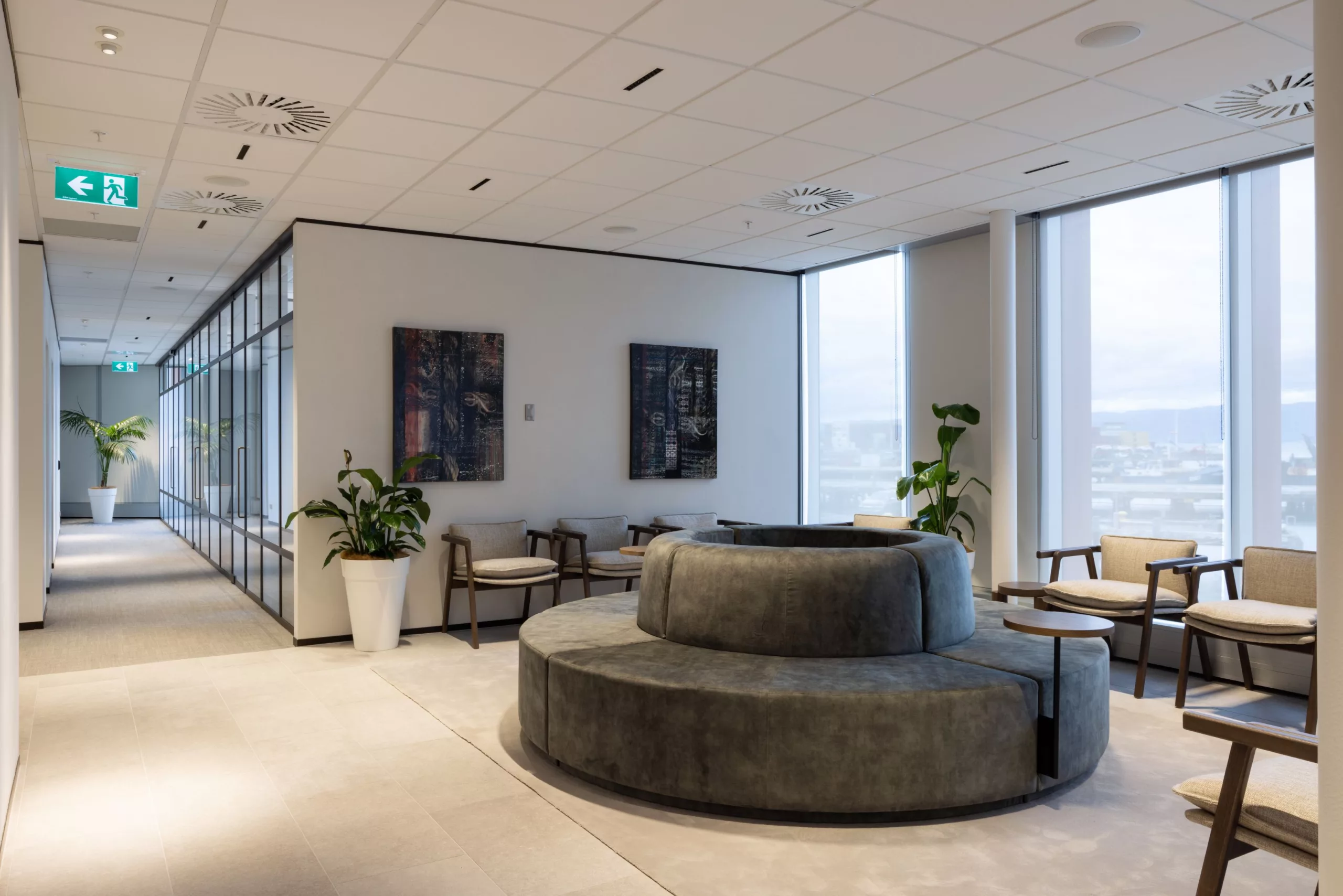 Ceramic Tiles
Ceramic Tiles
Ceramic tiles come with a few drawbacks. While they look excellent, grout poses a hygiene risk as it is porous and can trap moisture.
Epoxy grouting is one solution to this, but this can be costly because it is a lot harder to install correctly than regular grout. We would limit tiled areas to spaces like kitchens or staff areas where hygiene is of slightly less significance.
Stainless Steel
As previously mentioned, stainless steel panels are great for adding durability to walls. But that isn’t their only use.
Stainless steel is ideal for infection control. On its non-porous, non-corrosive, and heat-resistant surface, it helpfully limits bacterial growth in spaces where this matters most. Additionally, its durability means it can be rigorously cleaned and sterilised over and over again without showing wear.
Q) What grade of stainless steel should I get for my Medical Facility?
While tempting to opt for a cheaper option, choosing a lower grade of stainless steel can make your space feel tacky and is a lot more susceptible to scratching. In the long run, it may be more expensive if you have to recoat or replace the stainless steel.
Therefore, we recommend opting for 316-grade stainless steel for a wall finish, as it has high tensile strength, good creep and stress rupture properties, and excellent toughness at both high and low temperatures.
Stainless steel can be finished with a brushed or patterned finish if you want an aesthetically pleasing surface.
Glass
If you want a lighter and brighter Medical Facility, you should incorporate glass partitioning into your fitout.
Q) Where should I use glass in my Medical Facility?
Glass partitioning can still let light through while being glazed for privacy or personalisation. This makes them ideal for the front of consult rooms, as the glass both lets light into the rooms and elevates the look and interest of the corridor beside them.
Consider the amount of glass you plan to use. Single sidelights beside doors use a small amount of glass and are subsequently more private, while larger glass partitions are more suitable for less private spaces like waiting areas.
Glass also shines in kitchens as splash backs, as it is completely non-porous and easily wipeable. It can be applied to wood or any other feature splashback to give it a hardy protective coating. Also, glass can be painted on on one side and then installed as a splashback with the painted side facing outward, through the glass. This leaves a smooth, glossy, and practical surface that is ideal for cleaning.
Tip: Glass can also be applied over painted walls in surgical in treatment areas to give these walls a hard and durable surface that is very hygienic and easy to clean!
Wood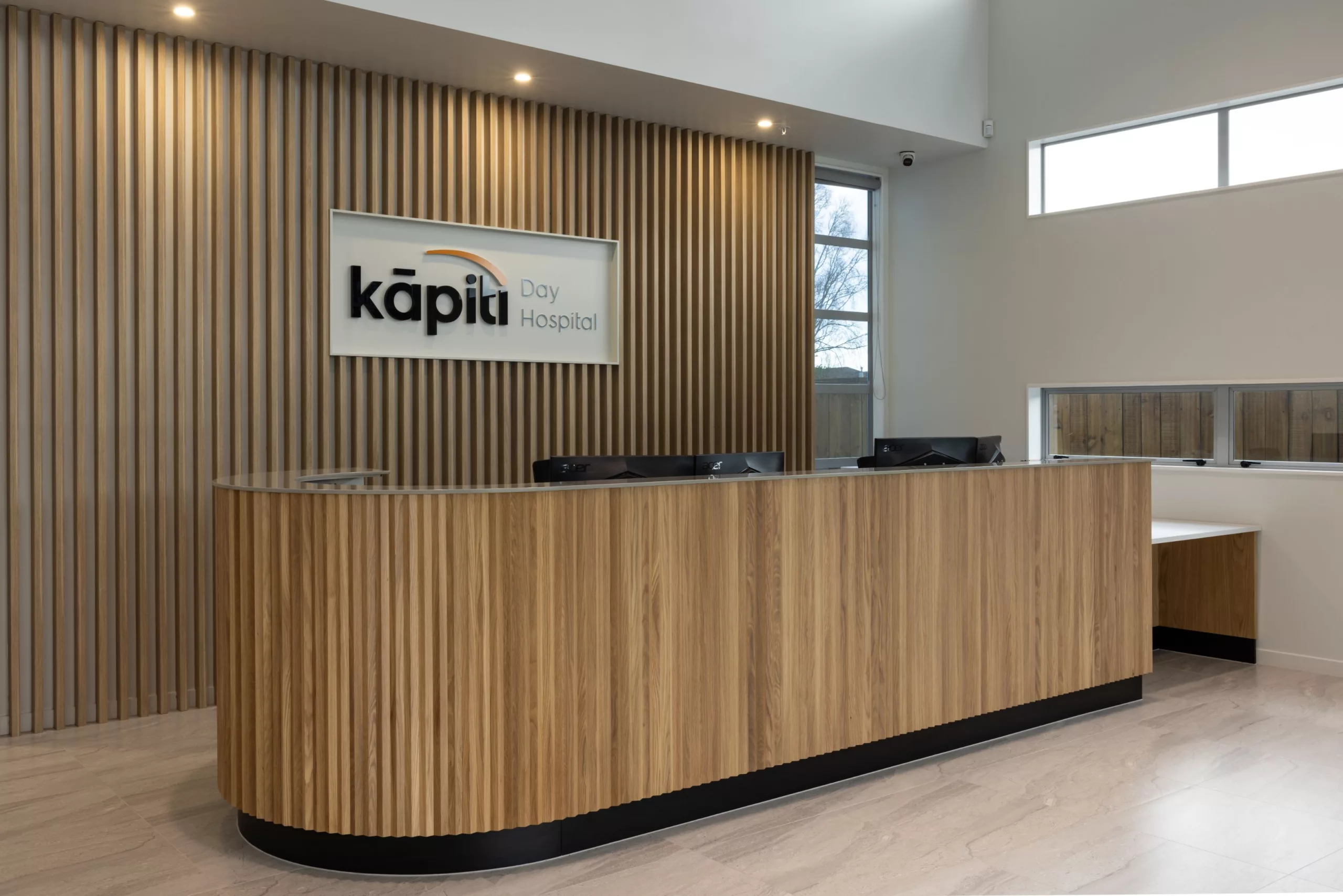
Wood certainly elevates the look and feel of your facility walls, but there are some viable alternatives to consider first.
Since solid wood feature walls are very costly, and wood veneers are very damage-prone and less suitable for rigorous cleaning, we would suggest browsing the wooden-look vinyl available, particularly the DI-NOC range.
Some of this vinyl offers a very realistic and textured finish, with specifications perfectly suited to a medical facility in terms of durability and infection control. Also, they are much more fire resistant when compared to wood products, so they are safer.
Acoustic + Feature Walls
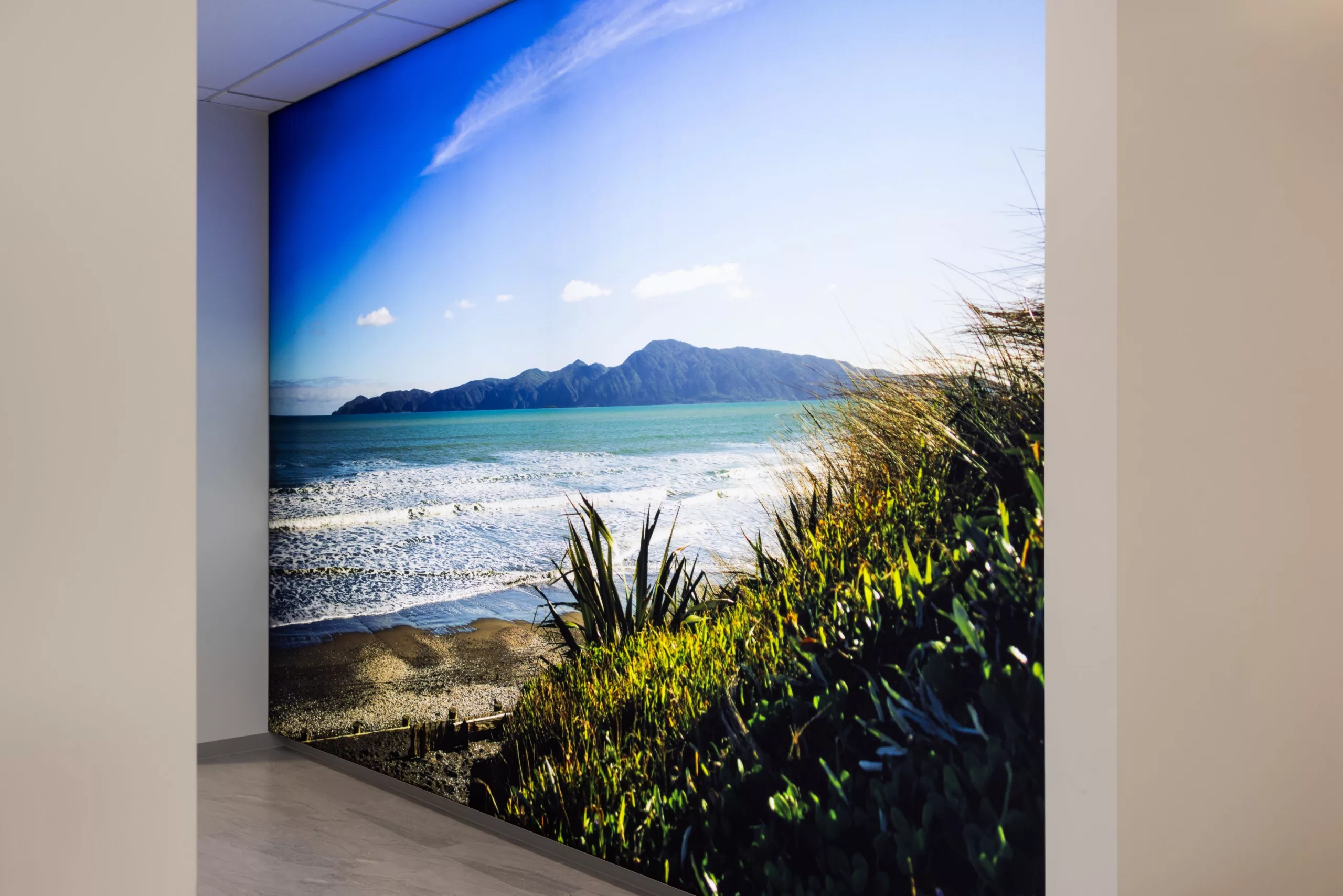 Finally, get creative!
Finally, get creative!
Your medical reception especially is an excellent place to add a touch of personalisation to your fitout and create a welcoming first impression for your patients
Nothing is holding you back from incorporating some standout design elements onto your walls. These can include printed graphics on glass or screens, soft acoustic panelling, and any other feature 3D or eye-catching features.
The ranges at Autex and Graphic Glass are some of our favourites for acoustic and graphic options.
We hope this blog has given you some helpful advice about choosing wall finishes for your medical practice.
If you have any questions about this article or medical fit-outs in general, Contact Us today!
Interested in starting your own medical facility? Check out our article on what to consider when investing in your own medical start-up.
